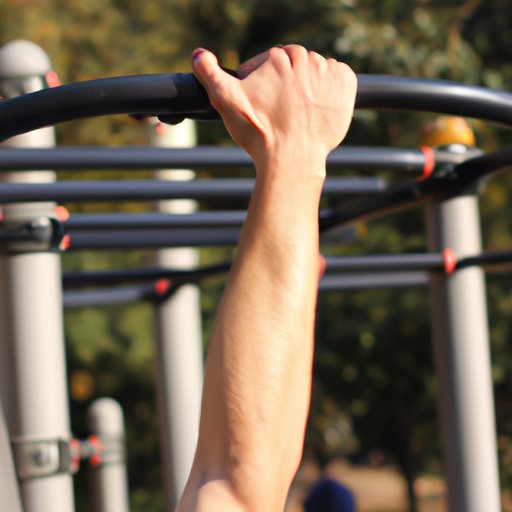
Introduction
Pull-ups are one of the best exercises you can do for overall fitness. Not only do they work your back and arm muscles, but they also increase grip strength, improve posture, and boost overall body strength. In this article, we’ll provide you with a comprehensive guide on how to do pull-ups, from mastering the basics to advanced techniques.
The Beginner’s Guide to Pull-Ups: Mastering the Basics
If you’re new to pull-ups, it’s essential to start with the basics to avoid injury. Here are some tips to get you started:
First, grasp the pull-up bar with your palms facing away from you, shoulder-width apart. Then, pull your shoulder blades down and back, engaging your core muscles, to hoist your body up until your chin is level with the bar. Lower yourself back down until your arms are straight. Perform three sets of ten repetitions, resting for 60 seconds between each set.
Remember to engage your muscles, avoid swinging your body, and use a grip that is most comfortable for you.
Additionally, increasing grip strength can help you do more pull-ups. Here are some exercises to improve grip strength:
- Farmer’s Walks
- Plate Pinches
- Towel Holds
Mistakes to avoid include swinging with momentum, using improper form, or arching your back. Be sure to start slow and work your way up, increasing the number of reps and sets as you become more comfortable.
4 Simple Steps to Increase Your Pull-Up Strength
If you’re struggling to do pull-ups, don’t worry – many people encounter this obstacle. Here are four exercises to improve your pull-up strength:
- Lat Pulldowns
- Negative Pull-Ups
- Assisted Pull-Ups
- Bodyweight Rows
Furthermore, it’s essential to work on overcoming mental obstacles, such as negative self-talk or limiting beliefs. Visualize yourself achieving your goals and stay consistent with your training.
From Zero to Hero: Our 30-Day Pull-Up Challenge
If you’re ready to take your pull-up game to the next level, consider trying our 30-day pull-up challenge. Here’s how it works:
Day 1: Perform one pull-up
Day 2: Perform two pull-ups
Day 3: Perform three pull-ups
Continue incrementing up to day 30, where you’ll perform 30 pull-ups.
It’s important to track your progress, so you know when to increase the number of reps or sets. Additionally, consider supplementing your pull-up training with endurance training, such as running or cycling, to improve overall performance and muscle endurance.
The Science of Pull-Ups: Understanding Anatomy and Mechanics
Understanding the anatomy and mechanics behind pull-ups can help you perform them with proper form and technique. Here’s what you need to know:
Pull-ups activate various muscle groups, including the lats, traps, biceps, and core muscles. It’s essential to maintain proper form, keeping your elbows close to your body and avoiding arching your back. Additionally, different grip positions, such as a wide grip or narrow grip, can activate different muscles.
Remember to warm up properly and avoid overworking one muscle group. Consider incorporating rest days into your routine to allow your muscles time to recover and grow.
Advanced Pull-Up Techniques: Tricks and Variations to Take Your Skills to the Next Level
If you’re already a pull-up master and want to challenge yourself, try incorporating these advanced techniques:
- Archer Pull-Ups
- L-sit Pull-Ups
- One-Arm Pull-Ups
- Muscle-Ups
Additionally, consider incorporating pull-ups into a more challenging workout routine, such as a calisthenics or CrossFit program. Be sure to maintain proper form and listen to your body to avoid injury.
Conclusion
Pull-ups are an excellent way to improve overall fitness and build strength. Whether you’re just starting or want to try advanced techniques, remember to stay consistent, track your progress, and listen to your body. With practice, patience, and persistence, you can master the art of doing pull-ups.
Final Tip: Don’t forget to fuel your body with the proper nutrition, such as lean protein, carbohydrates, and healthy fats, to support muscle growth and repair.





